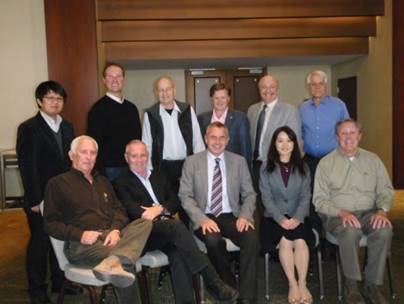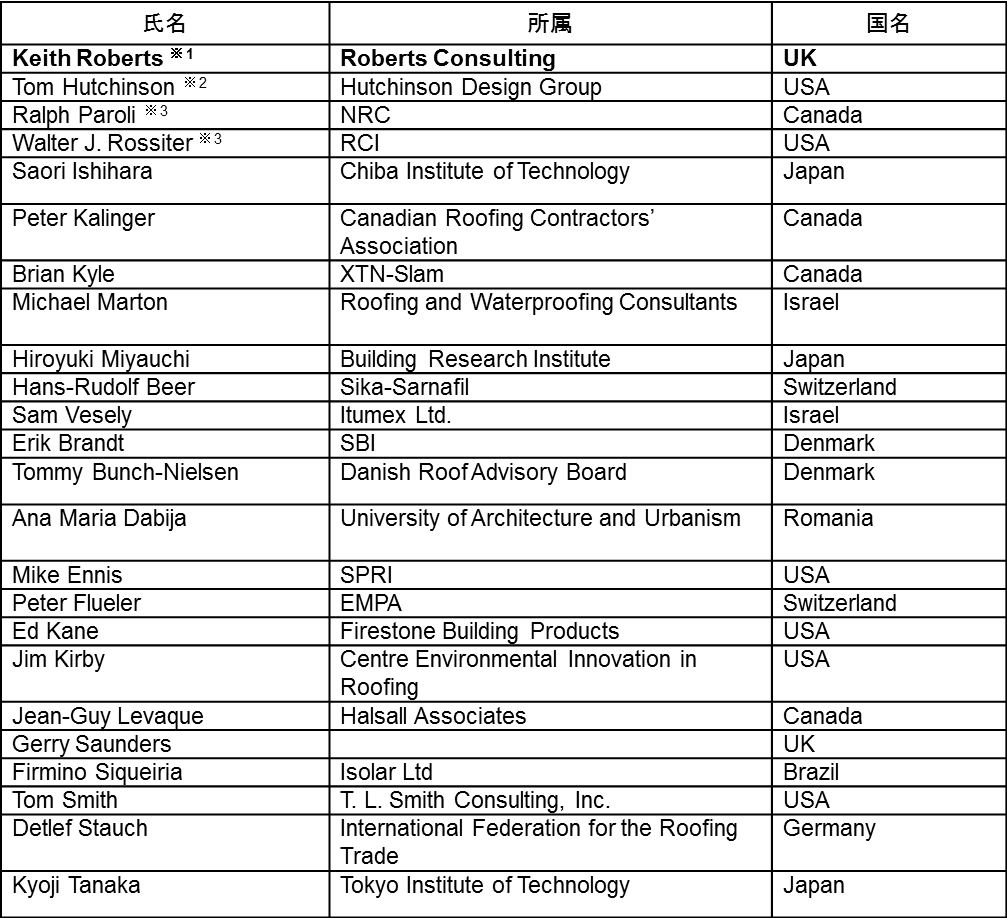CIB/RILEM発 「信頼性の高い屋根を作るための基本事項」
CIB/RILEM発 「信頼性の高い屋根を作るための基本事項」
宮内博之委員(建研)が建築学会大会で発表
建物の完全な防水を実現するには、①防水に関わる仕様書や規格の遵守(ハード改革)と、②防水に携わる関係者が防水の重要性を十分に認識して取り組むこと(ソフト改革)が必要である。特に②において、防水施工時の技能や管理は最も重要な部分となる。
建築研究所の宮内博之氏は「防水に関連する建築様式は各国の風土や文化に深く関わっている技術まで規定することは難しい。しかし、ソフト面では万国共通的要素が多い。」として、去る9月13日、神戸で開催された2014年度建築学会大会(近畿)、屋根防水にかかわる国際会議活動の事例として、材料施工部門の研究協議会で、CIB W83/RILEM Joint Committeeの活動状況を報告した。

2013年11月 CIB W83/RILEM委員会出席者。(前列中央:Keith Roberts主査)。
日本側の委員は宮内氏(後列左端)と石原沙織千葉工業大学助教(前列右から2人目)である。
CIB W83/RILEM Joint Committee・屋根材料・工法に関する国際合同委員会は、1996~2000年の間に国際活動していた屋根の専門家・技術者によって設置された組織で、屋根材料・工法に関わる調査、ガイドライン作成、及び屋根技術の国際的普及活動を目的として活動している。宮内氏によると、屋根材料・工法に関する国際合同委員会(CIB W 83 / RILEM Joint Committee on Roofing Materials and Systems)は、「防水は特別な技術ではなく、基本に忠実に従うことが重要である」との認識を持ち、「世界各国の防水に携わる者が共通認識を持って取り組まなければならない要素について議論している」という。
CIB W83/RILEM Joint Committee名簿

※1:Chair,※2:Sustainable Task Group Chair,※3:Past Chair
(図をクリックすると拡大します。)
ここでは宮内氏が、建築学会研究委員会で「海外の動向」として報告したCIB W83/RILEM合同委員会の活動の中から、同委員会が2014年6月ICBEST国際会議で発表した「信頼性の高い屋根を作るための基本事項としての12項目」を紹介する。
Reliable Roofing: 信頼性の高い屋根を作るための基本事項
宮内 博之 独立行政法人 建築研究所、主任研究員、(工学博士)
CIB W83/RILEM Joint Committee屋根材料・工法に関する国際合同委員会は、1996~2000年の間に国際活動していた屋根の専門家・技術者によって設置され、屋根材料・工法に関わる調査、ガイドライン作成、及び屋根技術の国際的普及活動を目的として活動している。メンバーは表1の通りで、Keith Roberts氏を主査として毎年1回以上開催されている。
屋根材料・工法に関する国際合同委員会(CIB W 83 / RILEM Joint Committee on Roofing Materials and Systems)本委員会の主査であるKeith Roberts氏は、屋根からの漏水・損傷に関わる問題について、世界で共通認識を持って解決していく取り組みを実施している。表2に示すにように信頼性の高い屋根を作るための基本事項として、12項目を提示しており、世界各国の言語に翻訳をし、2014年6月ICBEST国際会議で、”Improving the reliability of roof constructions: report from CIB/RILEM International Committee”の研究成果を発表している。
その基本事項の日本語訳は次の通りである。

2014年9月13日の建築学会大会で海外の動向を発表する宮内氏。
TENETS OF RELIABLE ROOFING (原文)
Introduction
As roof systems become more complex we face the risk of losing sight of the principal objective of a roof in providing shelter from the wind and rain. As an industry we all aspire to build roofs that meet the building owner’s need for protection from the weather. It is recognised that on occasion roofs do leak or become detached. The CIB / RILEM Joint Committee set out to identify specific actions and priorities that will improve confidence. Each command or ‘tenet’ on its own is no more than common sense. However, when read together, the instructions will help to improve the reliability of the roofs we design and build. The need for training and experience is common to all of the tenets.
Objective
To collectively identify actions and priorities that can improve the reliability of roofing systems.
1. Retain and disseminate knowledge base
Across the world we already have the knowledge in centres of excellence of how to build a reliable roof. There is an ongoing need for the transfer of this knowledge through training and continuing professional development. The loss of experienced personnel through retirement or redundancy is a threat.
2. Prepare contract documentation
The drafting of project specific drawings and specifications is an essential early stage. There should be proper co-ordination with other roof related disciplines, including structural, heating & ventilating and plumbing. Consideration should be given to the long term maintenance of the roof including a safe means of access.
3. Adopt positive drainage
Roofs that are laid sloped to drains have fewer problems and less call backs to site to resolve leaks after completion. Drainage outlets need to be properly designed with sufficient capacity and connected into the rainwater goods system.
4. Introduce element redundancy
A double layer roof is a good example of a roof which has inbuilt redundancy. If the outer layer were to leak there would still be a secondary drainage path below so that rainwater does not enter the building. Another practical example is the introduction of an overflow pipe through a roof parapet.
5. Co-ordinate details
A significant number of roof call backs are a result of flaws in the detailing of the roof, from design to installation. Careful attention should be given to the detailing, adopting standard details that are simple, practical and robust. On complex roofs and on large roofs with significant repetition, the construction of a full scale mock-up in advance is helpful for checking that the details can actually be built and for seeking improvements.
6. Ensure adequate resources
Resources are needed to build a roof both in terms of finance to pay for the materials and labour, and time to do the work. At the tender stage assess the full life costing of the roof when comparing alternative schemes and methods.
7. Substitute with care
Changing a specified part of a roof system to an alternative product can introduce unforeseen difficulties in the future, such as a lack of compatibility, ultimately increasing the risk of water ingress. Documentation of product performance is needed in the consideration of an alternative. A cautious approach should be adopted to the substitution of products, particularly if the changes are hurriedly proposed, whilst recognising the value of innovation in construction.
8. Manage effectively throughout the project
For the construction of a reliable roof there is a need for advance planning to ensure the proper sequencing of work, together with the timely supply of the correct materials, tools and equipment. On completion of a roof it is important to protect the finished surfaces from damage by follow-on trades.
9. Engage competent applicators
Roofing failures are reduced where there are established training schemes for roofing tradesmen supported by organised roofing trade federations. Applicators should have experience in the chosen roofing system.
10. Inspect and test
Checking the quality of materials and work during the roof assembly is recommended, recognising the difficulties in putting the roof right after completion. Non destructive test methods can be beneficial in identifying timely corrective actions.
11. Plan maintenance
After completion there will be an ongoing need for the building owner to take responsibility for planned maintenance in the form of routine inspections and good quality repairs as necessary. Restricting roof access to only those who have a need to go onto the roof minimises everyday damage.
12. Learn from experience
On completion of a project there is an opportunity to critically review the performance and to give constructive feedback to the designers, contractors and manufacturers. This leads to product development. This virtuous circle can reduce the repetition of mistakes whilst raising general standards and the expectations of the building owner that the roof will be reliable. This is a motivator for innovation.
― 信頼性の高い屋根を作るための基本事項 ―
(1)はじめに
屋根は複雑になってきており、風や雨から我々を守るシェルターでなければならないという屋根本来の役割を、ともすれば見失いがちになるというやや危機的な状況に直面している。そのような中で屋根工事に携わるものは、厳しい屋外環境から守ってほしいという建物所有者の基本的要求に応えるべく、しっかりとした屋根を作り上げようとしているが、今もって屋根からの漏水、損傷等は発生している。
これらを背景に建築研究国際協議会(CIB)と国際材料連合構造試験研究機関・専門家連合(RILEM)との連合委員会では、屋根の信頼性を高めるための諸事項について検討した。個々の項目は常識的なことばかりであるが、それらを合わせて通して読み、実行するように心がければ、我々が設計し、作り上げる屋根の信頼性向上に大いに役立つと思う。訓練とか経験が必要なことは、すべての項目に関して共通であることは言うまでもない。
(2) 目的
屋根の信頼性を高めるためになすべきこととその重要性を明確化することを目的とする。
①知識を蓄え、活用せよ。
世界的にみても我々はすでに、信頼性の高い屋根を作るためにどうすべきかについては、かなりの知識を保有している。今後は教育訓練や自己啓発を通して、これらの知識を伝達してゆく必要がある。退職や解雇のために経験豊かな人々が、次々といなくなっていることは将来に対する脅威である。
②契約時にしっかりとした文書を準備せよ。
当該建物の詳細図面と仕様書は初期の段階に整備しておく必要がある。これらは施工段階での関連分野、構造、空調、配管等と連携して仕事を進める上で不可欠だからである。その際メンテナンスのために屋根の各部に安全に接近できるといったことを含めて、長期間にわたる維持管理に係わることがらへの配慮も必要である。
③積極的に排水せよ。
ドレンに向かって十分な勾配のつけられている屋根では、漏水トラブルが少なく、完成後漏水修理のために、現場に呼び出されることも少なくなる。また排水口は十分な排水能力を確保し、しっかりした雨水排水設備に接続する必要がある。
④屋根部材にはゆとりをもたせよ。
屋根を二重にすることは安全性にゆとりを組み込むための好例である。万が一上側の屋根で漏水したとしても下側の屋根が2次的な排水面となり、雨水を室内に入り込ませないからである。パラペットの一部を開けてオーバーフロー管を設けることも、実現可能なゆとり設計の例である。
⑤適切な納まりとせよ。
現場に呼び出される屋根不具合のかなりのものは、納まりの部分の設計から施工にいたるまででの何等かの不備の結果である。そのため単純であるが実用的で、しかも堅牢である標準的納まりを採用するなどして、納まりを万全にしておく必要がある。複雑な形状の屋根あるいは同じ形状が繰り返されるような大面積の屋根では、事前に納まりの不備を調べ改善するための実大模型を作ることは有効である。
⑥必要とされる資源量のことを考えよ。
屋根を作るためには、材料や労働に対して支払わなければならない経費、作業に要する時間といった資源量について考えておく必要がある。そのためには入札時に複数の案と方法について、屋根に要する全ライフコストを評価し検討することが大切である。
⑦代替品には注意せよ。
屋根構成部材の特定部分を他の製品に切り替えることは、時として将来に予期せぬ問題を引き起こすことがある。例えば構成部材間の整合性が欠落することにより漏水の危険性が高まるといったことである。代替品を採用する際には、その製品の性能に関する文書を十分読んで理解して採用することが大事である。特に変更提案が短期間で提出された場合には、もちろんそのことにより価値が高まることは理解しつつも、慎重な取り組みが求められる。
⑧プロジェクト全体を通しての作業管理を効率的にせよ。
信頼性の高い屋根を作り上げるためには、必要な材料、工具、装置などをタイミングよく準備するなど、作業を滞りなく進めるためのしっかりとした計画は大事である。さらに工事完了後も、その後に行われる他工事で損傷を受けないように仕上げられた表面を保護しておくことは重要である。
⑨力量のある職人を雇用せよ。
屋根の損傷は、屋根工業連盟などの団体により組織された屋根工事作業者のため訓練プログラムが整備され、実施されている地域では減少している。そのため屋根工事に係わる作業者が、当該の屋根の仕組み、工事に習熟していることは不可欠である。
⑩検査と試験を実施せよ。
完成した後で屋根の不具合箇所を直すのは難しいことを考えると、施工中に材料品質と施工品質をチェックしておくことを強く勧める。非破壊試験方法は適正に施工されているかどうかの確認手法としては有用である。
⑪維持管理をしっかり計画せよ。
建物所有者には屋根完成後、事前に維持管理計画に従っての定期的な検査、および必要に応じての修繕の責任がある。屋根には必要な人だけが立ち入ることができるように制限すると、不特定多数のひとによる損傷を抑えることができる。
⑫経験からしっかり学べ。
プロジェクトが完成した時は、出来上がったものの性能をいろいろな角度から検討できる絶好の機会であり、設計者、施工者、材料製造業者に有益な情報をもたらしてくれる。これはその後の製品の開発に大いに役立つ。この好循環は不具合の発生を抑制すると同時に、全般的な水準を向上させ、最終的には建物所有者にとっての屋根の信頼性に対する期待に応えることになる。これはさらなる開発への強い動機づけともなる。
宮内博之氏 プロフィール
宮内 博之 (Hiroyuki MIYAUCHI, Dr. Eng.)
独立行政法人 建築研究所材料研究グループ 主任研究員
専 門 建築防水・仕上材・コンクリート
略 歴
1996年 東京都立大学 工学部 建築学科 卒業
1998年 東京工業大学大学院 総合理工学研究科 環境物理工学専攻 修士課程 修了
1999年 東京工業大学 応用セラミックス研究所・建築物理研究センター 助手
2003年 東京工業大学・博士(工学)取得
2006年 カナダ・National Research Council Canada客員研究員
2007年 東京工業大学 応用セラミックス研究所・建築物理研究センター 助教
2008年 韓国・忠南大学校 工科大学 建築工学科 助教授
2013年 韓国・忠南大学校 工科大学 建築工学科 副教授
2014年 独立行政法人 建築研究所 材料研究グループ 主任研究員(~現在)
最近の主要な研究活動
建築研究所重点研究課題「建築物の戦略的保全に資する建築部材の物理的耐久性の評価技術の開発」(2014年度~)
韓国研究財団・中堅(個人)「建築外壁接合部の防水評価試験方法の開発とフェイルセーフ設計法の構築」(2012~2013年度)
韓国研究財団・一般(基本)「建築外装材の超促進型環境劣化シミュレーター開発と耐久性能設計法の構築」(2010~2013年度)
韓国学術振興財団・一般(新人)「建築仕上材下部のコンクリート亀裂部の中性化評価と建築外皮の耐久性予測」(2009~2012年度)
韓国学術振興財団・一般(基本)「コンクリートの耐久性に影響を及ぼす建築仕上材のガス透過性能評価」(2009~2010年度)
日本学術振興会・科研基盤(B)「暴風環境下における金属・メンブレン防水屋根の耐風性評価」(2008年度)
2014/09/21(日) 07:36:15|ニュース|


